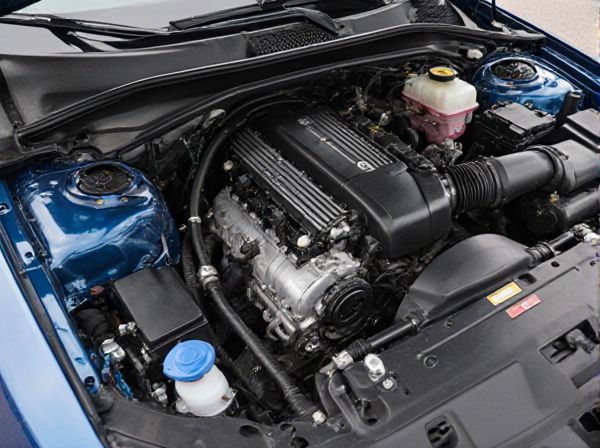
Photo illustration: Variable Valve Timing vs Fixed Timing
Variable Valve Timing optimizes engine performance by adjusting the timing of valve operation based on driving conditions, enhancing fuel efficiency and power output. Fixed Timing uses a set valve operation schedule, which can limit engine responsiveness and efficiency under varying speeds and loads. You benefit from improved acceleration and lower emissions with variable systems compared to the consistent but less adaptive fixed timing.
Table of Comparison
| Feature | Variable Valve Timing (VVT) | Fixed Valve Timing |
|---|---|---|
| Valve Timing | Adjustable based on engine speed and load | Set to a constant timing for all conditions |
| Performance | Optimizes power and torque across RPM range | Limited performance, optimized for specific RPM |
| Fuel Efficiency | Improves fuel economy via adaptive timing | Less efficient due to fixed valve operation |
| Emissions | Reduces emissions with optimized combustion | Higher emissions from less precise control |
| Complexity | Mechanically and electronically complex | Simple design, easy maintenance |
| Cost | Higher manufacturing and repair costs | Lower cost due to simpler mechanism |
Introduction to Valve Timing Technologies
Variable Valve Timing (VVT) optimizes engine performance by adjusting the timing of valve operation dynamically based on engine speed, load, and other parameters, enhancing fuel efficiency and reducing emissions. Fixed timing systems maintain a constant valve operation schedule, limiting adaptability to different driving conditions and leading to less optimized combustion. Advanced VVT technologies, such as Honda's VTEC and Toyota's VVT-i, demonstrate significant improvements over fixed timing by improving torque, power delivery, and overall engine responsiveness.
Understanding Variable Valve Timing (VVT)
Variable Valve Timing (VVT) enhances engine efficiency by dynamically adjusting the timing of valve opening and closing according to driving conditions, optimizing air-fuel mixture intake and exhaust gas expulsion. Unlike Fixed Timing systems, which operate with a set valve schedule regardless of speed or load, VVT improves fuel economy, reduces emissions, and boosts power output. Technologies like Honda's VTEC and Toyota's VVT-i exemplify practical VVT implementations that adapt valve timing in real-time for superior engine performance.
Exploring Fixed Valve Timing Systems
Fixed valve timing systems utilize a predetermined, non-adjustable camshaft design that controls the opening and closing of engine valves at set intervals. This simplicity offers cost-effective manufacturing, reduced mechanical complexity, and reliability under consistent operating conditions. However, fixed timing limits engine efficiency and performance across varying speeds compared to variable valve timing systems, which optimize valve operation based on real-time engine demands.
Key Differences Between VVT and Fixed Timing
Variable Valve Timing (VVT) dynamically adjusts the timing of valve opening and closing to optimize engine performance, fuel efficiency, and emissions under different driving conditions. Fixed Timing uses a constant valve opening and closing schedule, which limits adaptability, resulting in less efficient combustion and reduced performance flexibility. VVT systems enhance torque, power output, and fuel economy by varying valve timing, whereas fixed timing remains static, maximizing simplicity but sacrificing potential performance gains.
Performance Impacts of Variable vs Fixed Timing
Variable Valve Timing (VVT) enhances engine performance by dynamically adjusting valve operation to optimize airflow and combustion across different RPM ranges, resulting in improved power output, fuel efficiency, and reduced emissions compared to fixed timing systems. Fixed valve timing limits performance by operating valves at a single predetermined setting, causing suboptimal airflow and combustion efficiency at varying engine speeds. Engines with VVT exhibit greater torque flexibility and responsiveness, especially during acceleration and high-demand scenarios.
Fuel Efficiency Comparison
Variable Valve Timing (VVT) enhances fuel efficiency by adjusting the timing of valve operation to optimize air-fuel mixture intake and exhaust gas expulsion across different engine speeds. Fixed valve timing, while simpler, delivers suboptimal combustion efficiency due to its static valve operation, leading to increased fuel consumption, especially under varying load conditions. Engines equipped with VVT typically achieve better mileage and reduced emissions by dynamically matching valve timing to driving demands.
Emissions and Environmental Considerations
Variable Valve Timing (VVT) significantly reduces emissions by optimizing valve operation according to engine speed and load, improving fuel combustion efficiency and decreasing pollutants such as NOx and CO2. Fixed Timing engines lack this adaptability, leading to higher emissions due to less efficient fuel burn and increased unburned hydrocarbons. Adopting VVT technology supports stricter environmental regulations and contributes to lower overall vehicular environmental impact.
Maintenance and Reliability Factors
Variable Valve Timing (VVT) systems require more frequent maintenance due to their complex components like cam phasers and solenoids, which can wear out or malfunction, leading to potential reliability issues. Fixed timing engines have simpler valve mechanisms, resulting in lower maintenance costs and higher reliability over time but may sacrifice performance and fuel efficiency. Proper lubrication and timely oil changes are critical for VVT systems to prevent sludge buildup that can impair valve timing accuracy and system longevity.
Cost Implications: VVT vs Fixed Timing
Variable Valve Timing (VVT) systems generally incur higher upfront costs due to added complexity, sensors, and actuators compared to fixed timing engines. Maintenance expenses for VVT engines may also increase, given the need for specialized parts and potential electronic component replacements. However, VVT can improve fuel efficiency and emissions, potentially reducing long-term operational costs despite higher initial investment.
Choosing the Right System for Your Needs
Variable Valve Timing (VVT) adjusts the timing of a vehicle's valves dynamically, enhancing fuel efficiency, power, and emissions control compared to Fixed Timing systems with static valve operations. Drivers seeking optimal performance and adaptability in diverse driving conditions benefit from VVT technology, while Fixed Timing suits simpler, cost-effective engines with consistent performance demands. Evaluating factors such as driving style, fuel efficiency priorities, and maintenance costs helps determine the ideal valve timing system for your specific automotive needs.
 caratoz.com
caratoz.com